The Pacific Northwest Coast has often been called “The Graveyard of the Pacific.” In January 1906 the area claimed the passenger steamer Valencia. This wreck has been called the most tragic maritime disaster in the region’s history. An Olympia street – Valencia Avenue – named to memorialize the ship has since been renamed.
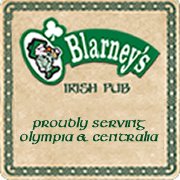 The Valencia Shipwreck
The Valencia Shipwreck
The Valencia was a 1,598-ton, 252-foot-long iron-hulled passenger steamer built by the William Cramp and Sons shipyard in Philadelphia in 1882. The Pacific Coast Steamship Company purchased it in 1902 and put the ship on its California to Alaska route.
In January 1906, the ship City of Puebla needed repairs, so the Valencia took over its next voyage. The Valencia set sail from San Francisco to Victoria, British Columbia on January 20 and soon ran into foul weather.
The vessel became lost when entering the Straits of Juan de Fuca. Then disaster struck. The Valencia ran aground on the isolated southwest coast of Vancouver Island. The wreckage became trapped on rocks beneath sheer rock cliffs. Many drowned as their lifeboats capsized. Rescue ships could only watch helplessly as the ship fell apart over the next 36 hours. Of the estimated 108 passengers and 65 crew, only 37 survived.
Olympia Counts Its Losses in Valencia Shipwreck
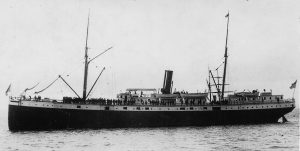
The world soon learned of the disaster. The Morning Olympian’s Seattle correspondent telegraphed news of the wreck on the night of January 23. The shocking story was quickly spread around the city and was announced in the evening Olympia Daily Recorder newspaper. News of the tragedy and recovery efforts filtered in over the next few days and weeks, while American and Canadian investigations dragged on for months.
Olympia was in mourning. “The sea has taken another heavy toll,” editors of the Morning Olympian wrote soberly on January 24, “The sinking of the Steamer Valencia with loss of 100 lives, brings up with awful significance the dangers to those ‘who go down to the sea in ships,’” quoting from Psalm 107.
Two people with connections to Olympia were killed in the wreck. B. M. Peter, father of Saint Martin’s University student Frank Peter, was lost in the wreck. Frank left school immediately to travel to Seattle for any news of his father’s fate.
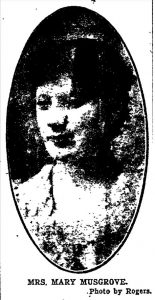
Mary Musgrove was another victim. A widow, she had left Olympia 10 years prior. She worked as a stewardess on the Hongkong Maru, on the Tokyo Kisen Kaisha steamship line. When that ship was taken over by the Japanese navy for their war with the Russian Empire, Musgrove was hired by the Pacific Coast Steamship company. She was not supposed to be on the Valencia’s doomed voyage, but another woman wanted to stay in San Francisco and she took her position.
Musgrove was hailed as a hero during the shipwreck, encouraging the other passengers. Like other women on the ship, she declined to take the last lifeboat and led others in singing the hymn “Nearer, My God, to Thee” – the same song sung during the sinking of Titanic six year later. Her picture and lyrics from the hymn were published in the San Francisco Examiner.
To honor Musgrove, photographer A. D. Rogers placed her picture alongside an article about her death from the Tacoma Ledger in one of his studio’s display cabinets. He had taken the photo of her years before.
Valencia Avenue, Olympia
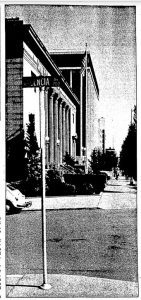
To commemorate the disaster, a new Olympia street was named for the Valencia. The exact origins of the road are difficult to trace, but no street in that location appears in early Sanborn fire insurance maps. References to the road begin in 1911 as preparations began for the construction of a post office on the site of the burned Hotel Olympia. In May of that year, the city council estimated grading of that street. The post office was completed (now Dolliver Building) in 1915.
People soon forgot the meaning of the road’s name. An unnamed journalist, writing for the June 2, 1944 issue of the Daily Olympian jokingly nominated it for the “Least-Known Street in Olympia,” writing that “All mail addressed to Olympians come from Valencia Street, but none is ever sent to any address on it. Valencia is a one-block-long thoroughfare that extends westward from Capitol Way. It passes by the Post Office in its brief course, but has no houses on it. Who named it Valencia?”
Valencia Becomes Talcott Avenue
In 1980, the now Valencia Avenue was renamed Talcott Avenue. The name was proposed by the Rotary Club of Olympia to honor Noyles Talcott, a leading downtown businessman, active in civic affairs.
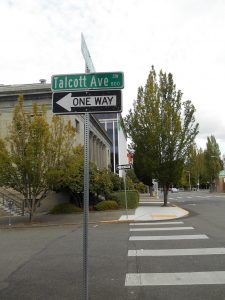
There was little opposition to the name change. At a Rotary meeting Olympian columnist Mike Contris, who supported the name change, mentioned one woman who was weary of name changes – during this period many road names were being replaced by numbers to aid mail and emergency vehicles. He summed up her thoughts on July 15: “Why, she asked, city leaders, well-intentioned again, want to change that beautiful Valencia Avenue—a memorial to a very historic event—to Talcott Avenue? Isn’t there a No-Name Street somewhere in our community? The residents of No-Name, certainly, wouldn’t mind No-Name being changed to Talcott!”
The Olympia City Council voted to approve the name and on June 30 the Rotary Club put up the new sign in an official ceremony. While the Valencia disaster has continued to haunt British Columbia history, it has been largely forgotten in Washington. Perhaps, to help remember, a brown historic name sign, “Valencia Avenue” could be placed on Talcott Avenue.

















































